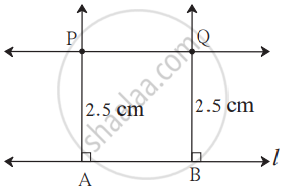Topics
Rational and Irrational Numbers
Parallel Lines and Transversal
- Pairs of Lines - Transversal
- Pairs of Lines - Angles Made by a Transversal
- Pairs of Lines - Transversal of Parallel Lines
- Properties of Parallel Lines
- Corresponding Angle Theorem
- Alternate Angles Theorems
- Interior Angle Theorem
- To Draw a Line Parallel to the Given Line Through a Point Outside the Given Line Using Set-square.
- To Draw a Parallel Line to a Given Line at a Given Distance.
Indices and Cube Root
- Concept of Exponents
- Multiplying Powers with the Same Base
- Dividing Powers with the Same Base
- Taking Power of a Power
- Multiplying Powers with Different Base and Same Exponents
- Dividing Powers with Different Base and Same Exponents
- Numbers with Exponent Zero, One, Negative Exponents
- Meaning of Numbers with Rational Indices
- Concept of Cube Number
- Concept of Cube Root
- Cube Root Through Prime Factorisation Method
Altitudes and Medians of a Triangle
Expansion Formulae
Factorisation of Algebraic Expressions
Variation
- Direct Variation
- Inverse Variation
- Time, Work, Speed
Quadrilateral : Constructions and Types
- Constructing a Quadrilateral
- Constructing a Quadrilateral When the Lengths of Four Sides and a Diagonal Are Given
- Constructing a Quadrilateral When Two Diagonals and Three Sides Are Given
- Constructing a Quadrilateral When Two Adjacent Sides and Three Angles Are Known
- Constructing a Quadrilateral When Three Sides and Two Included Angles Are Given
- Properties of Rectangle
- Properties of a Square
- Properties of Rhombus
- Properties of a Parallelogram
- Properties of Trapezium
- Properties of Kite
Discount and Commission
- Concept of Discount
- Commission
- Rebate
Division of Polynomials
- Polynomials
- Degree of Polynomial
- Dividing a Monomial by a Monomial
- Dividing a Polynomial by a Monomial
- Divide a Polynomial by a Binomial
Statistics
- Arithmetic Mean - Raw Data
- Subdivided Bar Graph
- Percentage Bar Graph
Equations in One Variable
- Solution of Equations in One Variable
- Word Problems of Equation in One Variable
Congruence of Triangles
- Congruence of Triangles
- Criteria for Congruence of Triangles
- SAS Congruence Criterion
- SSS Congruence Criterion
- ASA Congruence Criterion
- AAS (Or SAA) Test
- RHS Congruence Criterion
Compound Interest
Area
- Area of a Parallelogram
- Area of a Rhombus
- Area of Trapezium
- Area of a Triangle
- Area of Figures Having Irregular Shape
- Circumference of a Circle
- Area of Circle
Surface Area and Volume
Circle - Chord and Arc
- Properties of Chord of a Circle
- Arcs Corresponding to the Chord of a Circle
Notes
To draw a parallel line to a given line at a given distance:
Draw a line parallel to line l at a distance of 2.5 cm.

Steps of construction:
- Draw line `l`.
- Take two points A and B on the line `l`.
- Draw perpendiculars to the line `l` from points A and B.
- On the perpendicular lines take points P and Q at a distance of 2.5 cm from A and B respectively.
- Draw line PQ.
- Line PQ is a line parallel to the line `l` at a distance of 2.5 cm.
If you would like to contribute notes or other learning material, please submit them using the button below.
Shaalaa.com | To Draw a Parallel Line to a Given Line at a Given Distance.
to track your progress
Series: To Draw a Parallel Line to a Given Line at a Given Distance.
0%
